
Top: Najah Aldridge and Oneika Russell; Bottom: Petrina Dacres
Oneika Russell (Visual Artist) and Petrina Dacres (Researcher and Curator) are creative and cultural professionals at Tide Rising Art Projects . Their installation of Transformation: Objects and Images has been showing at the Clemente Soto Veléz Cultural and Education Center throughout July 2021, as part of The Clemente’s Intradiasporic Curators program. Initially established to present Latinx artists, the Intra-diasporic Curators Program presents a range of underserved and underrepresented artists through The Clemente’s curatorial platform within its Abrazo Interno and LES Galleries. The program is made possible with support from New York City’s Department of Cultural Affairs.
Najah Aldridge got a chance to interview Oneika Russell and Petrina Darces about the intentions for the exhibition and its meaning to contemporary Caribbean art. Aldridge is an Urban Democracy Lab Gallatin Fellow in Urban Practice at NYU where she is conducting her fellowship at The Clemente and exploring the intersections of the arts and public health in cultivating, presenting, and preserving Puerto Rican / Latinx culture.
NA: What drove this idea of transformation specifically through objects and images?
OR: I had a chance to meet various artists that are actually in the show [during residency at Caribbean Linked] so I met Tessa Mars, Dominique Hunter, and Katherine Kennedy and I had known, Alicia Brown, from art school, I noticed that there were all these artists that were making two dimensional work. I noticed that they were also extending imagery into three dimensions.
so I raised this with Petrina when she joined Tide Rising Art Project, and just told her I noticed this trend. Can we shape this idea into the basis for an exhubition? And I guess I’ll, I’ll hand that over to Petrina to finish up the idea
PD: Now, you know, being interdisciplinary and working with multiple media is not new for contemporary artists, but what is unique about this exhibition is the gathering and exhibiting of contemporary Caribbean artists around this idea of objects and images in relation which is part of the title of the exhibition. It provided an opportunity to showcase the ways some contemporary artists from the Caribbean were engaging multiple media as they worked through their ideas to show how some of their ideas were being remediated and to show some of the materials and forms they were manipulating. How do their ideas get transformed or enhanced and what are the various aesthetic possibilities that emerge as they shift from animation to textile or drawing to sculpture or painting to animation to installation? The exhibition offered artists an opportunity to experiment or extend some of their projects further.
The modern Caribbean as a space of hybridity – a space of ethnic, racial and cultural intermixing and a space of migration – both historical and contemporary – also offers a unique cultural vantage point to think through or challenge the perceptions of the stable and authentic image or object… perceptions that 20th century art and visual culture certainly undermined but nevertheless have persisted in moments, even today in the age of social media.
Certainly there is our social and economic experience of having to reuse and transform materials that in other regions get thrown away easily. And, some of our popular cultural traditions such as carnivals eschew permanence for an aesthetic preference of ephemerality. So this idea of transformation in artistic practice that we are considering also has cultural resonance.
NA: What first impression did you want the audience to have ?
PD:I wanted when they walked into the room to feel this sense of layering, but also in terms of the look of the exhibition to still feel like there was room enough to breathe and to take in each of the individual artworks because they stand on their own even though there are connections with other works in the room.
OR: One of the things that I wanted to have happen is to not focus the exhibition on it being centered around showcasing Caribbean art as the main ethos, or the main kind of mission. It was going to be also a show- on the actual work that was happening. And then, the fact that they were Caribbean artists was secondary.
NA: How did you want the audience to walk out feeling?
PD: Of course I want them to feel like they just saw a very strong exhibition of works. Because the artworks on view are very strong. Even if they don’t understand the ideas behind the works there is visual delight, visual curiosity, and visual estrangement. So I think these works can be appreciated on different levels.
I also wanted people to see multiple types of examples of contemporary Caribbean art. I recognize there’s a bias about Caribbean art, and I think part of what we do at Tide Rising is to try to promote an understanding of the multiple languages of artists in the region, particularly artists who are working in a contemporary vein. So that when people think about Caribbean art there is a wider knowledge of art practice in the region.
When you curate a show in the Caribbean there’s that sense of, you know, you’re speaking to an audience that understands and knows. Whereas, when you are based in the Caribbean and you’re carrying your show to places like New York, you also have to sometimes contend with other people’s understanding of the Caribbean, and other people’s ideas about Caribbean art.
I think part of what we are trying to do is to present different faces of art to a wider global public so that there is a breath of understanding of what is Caribbean art.
 https://www.instagram.com/tiderisingartprojects/
https://www.instagram.com/tiderisingartprojects/
NA: What did The Clemente have to offer you in relation to the physical space like the gallery itself, the brick walls outside the window to the artists in residence within the building and the organizations in residence as well?
OR: The legacy of The Clemente was known to me through my 2018 Residency Unlimited/ Davidoff Arts Initiative Residency. I knew various artists who had studios there and had talks there.when I went to New York at that time.
I knew that the institution was receptive to artists, particularly from this region that we’re from and are supportive of it. There were other spaces that we could’ve approached, and I was feeling a little bit uncertain that this type of show would find any resonance within a space in New York, or be handled or have that kind of context, that would support what we envisioned doing. I think it worked out well that The Clemente is the one that received the show. I think this environment positioned the show very well.
NA: How would you describe the exhibit of transformation in one word?
PD: I’m going to say thought-provoking.
There is something to engage, both in terms of material wonder, or aesthetic wonder, but also ideas. ach of the works offer something to think about, intellectually or critically
OR: I would say affirming.
Because there is a particular and special meta explorations and dialogues happening that needed to be seen together. And once they’re together, it’s going to produce this quite specific, but also connected to the larger kind of art industry with a very specific voice of what’s happening. I think seeing the show together has affirmed that idea for me that that was something that was actually there and that needed to be explored.
NA:What are the next steps for Tide Rising Art Projects in terms of this installation of transformation and beyond?
OR: So we are looking at preparing a proposal to have the show travel to other spaces, potentially in other countries where that conversation and this particular special kind of vision could be seen in other contexts. We’re excited about that.
PD: But the next major thing that’s also going to come out of the show is the documentary. We have a simultaneous documentary project that we are working on based on the interns we had assisting us in the exhibition install. The release of the documentary is slated for next year.
We do have other projects in the works. One of them is developing our store to help fund the work that we do, and also to provide engaging art materials for our audience. We launched our tiderisingartprojects.com store this year with limited edition prints and items by some of the artists in the exhibition. 100% of the proceeds of the sales go to the artists to help fund their material and shipping costs for this exhibition.
And we will also continue some of our digital programming that involve conversations with artists and short videos on their works. Our platform is Instagram, Facebook and YouTube mostly and those are all opportunities to spread the word about contemporary Caribbean art.
NA: Is there any advice that you would like to share for aspiring curators and artists in the Caribbean?
PD: You don’t have to only work in galleries or museums you can do your curatorial work and exhibit your artistic work through other platforms and spaces. I am inspired by artists and writers that have supported their practice outside of traditional established avenues. I also see collaboration as an important means for professional development. You don’t have to work alone. Find people that share your goals and with whom you can work to accomplish your vision.
OR: Sometimes in smaller art centres, the contemporary art scene can feel like an individualistic space and sometimes in a small space, like the Caribbean, it can be competitive.
It wasn’t until I was able to shift that perspective as an artist and chose to see it more as people who have similar goals, and share an ethos who really want the same thing – a developed thriving arts industry which we can all benefit from. It was then that I was able to focus on what I could add to this mission and also finding other team members and partners who also shared and wanted to help support that mission. For Tide Rising Art Projects it has been important as Petrina said to think collaboratively and approach things with each of us taking the role we are stronger at or need to develop in when we do projects. Working in this way has really helped us move forward with our goals as each team member’s role really becomes connected to their personal goals and mission.
By Najah Aldridge
Check out the installation Transformation: Objects and Images in Relation at The Clemente until July 31st!
To learn more about Tide Rising Art Projects visit: https://tiderisingartprojects.com/
Support Tide Rising Art Projects Shop here: https://tiderisingshop.company.site/?fbclid=IwAR3eJOeLXEUSummkDkeo9gQpJZ5RtoTPYQBECt3Y131JR7FIHaeFMSHJzS
To view their latest artistic projects, visit their Facebook page @tiderisingartprojects , Instagram page @tiderisingartprojects or Youtube account Tide Rising Art Project

Leave a Reply